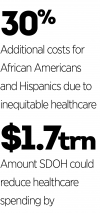Tackling the social determinants of health and rebalancing healthcare
With inequity in healthcare and economics creating numerous societal challenges, we can no longer wait to address the imbalance and provide innovative solutions to healthcare providers

Evidence suggests that currently available quantitative imaging technology is capable of deploying innovative precision medicine for improving treatment
In 1948, shortly after the end of the Second World War, the World Health Organisation (WHO) was formed. This institution was created as a means to coordinate international health efforts, defining health as “a state of complete physical, mental and social wellbeing, and not merely the absence of disease”.
On March 25, 1965, ahead of the second national convention of the Medical Committee for Human Rights in Chicago, Illinois, Dr Martin Luther King Jr proclaimed: “Of all the forms of inequality, injustice in healthcare is the most shocking and inhumane.” Just 13 years later, in 1978, the WHO and the United Nations Children’s Fund convened at the International Conference on Primary Healthcare held in Alma-Ata. For the first time, healthcare challenges facing developing countries were seriously examined, resulting in the Alma-Ata Declaration. This declaration recognised the need for primary care in all nations and established a demand for equitable healthcare access.
The social determinants of health (SDOH) were created by the WHO with the aim of identifying the main causes of global health crises
However, in 2019, equitable access to healthcare still remains a significant challenge, both within the US and around the world. The social determinants of health (SDOH) were created by the WHO with the aim of identifying the main causes of global health crises. Providing equitable healthcare is hindered, compounded and exacerbated by income inequality, with poorer patients among the most at risk for receiving inadequate healthcare. This group – which accounts for the largest instances of avoidable healthcare costs – is affected by increasing rates of chronic disease, and also comprises healthcare patients who are in greatest need of support as defined by the SDOH. According to the landmark study Beyond Health Care: New Directions to a Healthier America by the Harvard T H Chan School of Public Health, an individual’s zip code in the US is a more accurate indication of future health outcomes than genetics are.
Global healthcare delivery is taking its lead from studies such as Harvard’s, as well as The Economic Burden of Health Inequalities in the United States, published by the Johns Hopkins University School of Medicine and the University of Maryland. The study claims: “More than 30 percent of direct medical costs faced by African Americans, Hispanics and Asian Americans were excess costs due to health inequities – more than $230bn over a four-year period. And when you add the indirect cost of these inequities over the same period, the tab comes to $1.24trn.”
What was once an ethical debate on the ways to tackle poverty – largely through improving housing, food, transportation or employee health and wellness – addressing SDOH has now primarily become a matter of healthcare economics. Health interventions for populations, once deployed only by necessity, can now be considered a secure and direct way to inspire innovative healthcare delivery solutions aimed at improving SDOH.
Chief among the solutions being rapidly scaled and deployed in response to this issue are software as a service (SaaS) technologies, such as TAVHealth, Healthify, Unite Us, Aunt Bertha and NowPow. These systems will be rolled out within the healthcare IT domain, but demonstrate promise for having a real-world impact for populations at risk.

The common denominator among SaaS solutions is their ability to strengthen the connection between patients and community resources. Their objective is to determine, measure and track when a social determinant has been addressed across the patient’s delivered care. As a result, hospital readmissions across the US – currently a more than $17bn annual systemic cost – could be markedly decreased. Reducing the financial burden to hospitals while simultaneously improving clinical outcomes for patients should be the aim of emerging SDOH SaaS technology companies: in doing so, tech companies would be moving the needle on SDOH in a more cost-effective direction.
Nevertheless, in preventing, detecting and providing early diagnoses for chronic diseases, SDOH SaaS tech companies fall short. There is a huge opportunity to target and address populations and their community health, which remains a key factor of the global healthcare crisis.
Surveying the damage
According to the 2019 Health Intelligence Network survey Healthcare Benchmarks: Social Determinants of Health, which gathered the opinions of healthcare professionals and screened patient populations for social determinants by prioritising their responses: “High-risk patients (those with two or more chronic conditions) are the leading patient populations targeted for [SDOH] screenings.”
High-risk patients with two or more conditions made up 42 percent of the survey respondents. Patients using Medicaid comprised 37 percent, those with behavioural health conditions represented 36 percent, low-income patients 32 percent, and the dual eligible made up 31 percent. Meanwhile, disease-specific patients made up 31 percent and those on Medicare represented 29 percent of respondents. Disabled patients made up 24 percent, the uninsured were 22 percent, and infants and children were 18 percent. Finally, others made up just eight percent of respondents.
The above online survey may be corroborated by the Deloitte Centre for Health Solutions, which, with roughly 300 hospitals and health systems in the US, intends to identify current health-related social needs, activities and investments, as well as the potential future direction of the industry. Deloitte’s efforts were aimed at better understanding how hospitals and health systems are operating, along with developing an insight into the challenges they face within the larger healthcare ecosystem. Interviews took place at hospitals, health-plan meetings and non-profit community organisations. Two key takeaways from the study were that hospitals are screening patients based on their social needs, and that the healthcare system is shifting towards value-based care, which may spur more investment for tackling the health problems associated with social needs.
Hospital investments vary, and sustainable funding may be a challenge. The healthcare stakeholders interviewed think that addressing health-related social needs is the ‘right thing to do’, and expect that alignment with value-based care will continue to encourage partnerships and produce innovative solutions.
Connecting the dots
Americans from all demographic groups face challenges to fulfil basic needs for housing, transportation, food and social needs, all of which can negatively impact physical and mental wellbeing when absent. Building housing and providing food for every American in need, as well as addressing other SDOH issues, is simply not sustainable.

In summation, it is clear from the research on SDOH that the debate over whether social factors are fundamental causes of health and disease is essentially over. A large body of research currently shows that society can make you sick or can promote your health, depending on a wide variety of factors. With this direct relationship now uncovered and agreed upon, the next step is therefore to define the causes and consequences of this phenomenon.
A standard of care brought forward by the WHO would likely transform personal health, systemic healthcare and healthcare delivery, as the capabilities of real-time physical health data is garnered using a personalised digital physical exam screening (PDPES). This MRI scan non-invasively images full-body or organ-specific tissue, requiring no contrast mediums or radiation, thus offering unparalleled safety for patients, including for paediatric, renal, diabetic and elderly patient populations.
When employed in addition to point-of-care physical exams, PDPES may unveil the onset of chronic disease, occult pathology or disease progression, and could potentially transform global healthcare. This technology also has the capacity to circumvent issues of health disparity among diverse populations: for example, the ability to promote pre-emptive imaging and catch diseases before they progress to life-threatening stages could allow for earlier intervention by physicians, who could then produce patient management plans at the first stages of the disease. This view is shared by the WHO, which stated in a presentation entitled Increasing Access to Diagnostic Imaging in Developing Countries: the Asha Jyoti Mobile Clinic: “Diagnostic imaging plays an important role not only in identifying pathology and tracking the progression of a disease, but also preventing disease via screening.”
Imaging innovations in healthcare will take SDOH strategy to the next level, marrying upstream care with increased access to the patients with the greatest need. Imaging has the potential to be invaluable for all patients within the health continuum, whether downstream, midstream or upstream.
Prevention is better than a cure
Individuals, communities, health insurers and public health more generally are most effectively influenced beyond the walls of hospitals. Community organisations connected by SaaS technology currently only scratch the surface in terms of early disease intervention. Healthcare providers must go further by investigating the sources of the disease. One way to do so is by developing technology that unveils health issues caused by lifetime or generational exposure to unaddressed SDOH factors before diseases develop further, thereby improving treatment and preventing the costs to the healthcare sector associated with developed diseases. This is the invaluable potential of the personalised digital physical exam. For example, US hospital emergency department (ED) physician culture and inadvertent human error may undermine SDOH and cause avoidable hospital readmissions. Federally mandated procedures are often altered and patient history screenings are shortened in crowded EDs. This may be a new norm within US urban hospitals, and highlights the importance of mitigating and implementing a PDPES alongside standard health screenings within EDs.
In the wake of increased rates of chronic disease and acute illness around the globe, healthcare providers and policymakers cannot wait any longer. Evidence suggests that currently available quantitative imaging technology capable of deploying innovative precision medicine – i.e. the personalised digital physical exam – when used in conjunction with traditional bedside physical exams may bend the curve on chronic disease, health and healthcare inequity, the health and wellness digital divide, physician burnout, and total cost of care. This is known as the ‘quadruple aim’ – a robust, upstream SDOH solution.
The costs to individuals and the system of putting off this innovation are simply too great. We cannot wait any longer.













